The Apple iPhone 6s and iPhone 6s Plus Review
by Ryan Smith & Joshua Ho on November 2, 2015 8:00 AM EST- Posted in
- Smartphones
- Apple
- Mobile
- SoCs
- iPhone 6s
- iPhone 6s Plus
System Performance Cont'd
Moving on towards our more GPU-bound workloads, we use our standard test suite of benchmarks like GFXBench and 3DMark to get a good idea for performance. Unfortunately, due to the move to iOS 9 the Unity engine version used in Basemark X is no longer working so for now we’re left with 3DMark and GFXBench. There is also Basemark OS II’s graphics test, but this is embedded in a larger benchmark with CPU and storage performance tests.

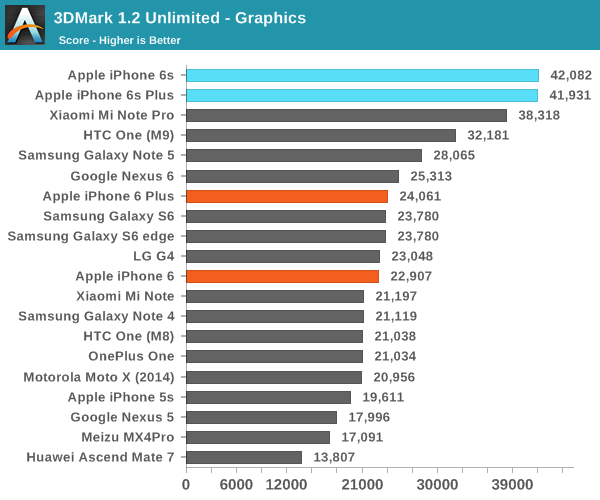
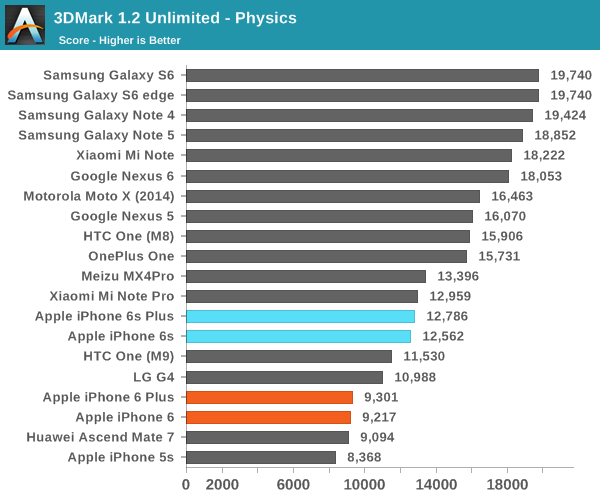
As always with 3DMark, there are some issues in the data structures used. Due to the data dependencies present within the physics test, it is necessary for the CPU to stall for data to be committed to memory before continuing on to the next portion of the test instead of executing instructions in parallel. This strongly reduces the practical performance of the CPU because the architecture is primarily focused upon instruction-level parallelism to deliver major performance gains. However, due to the strong showing in graphics performance the iPhone 6s’ still manage to take the lead.
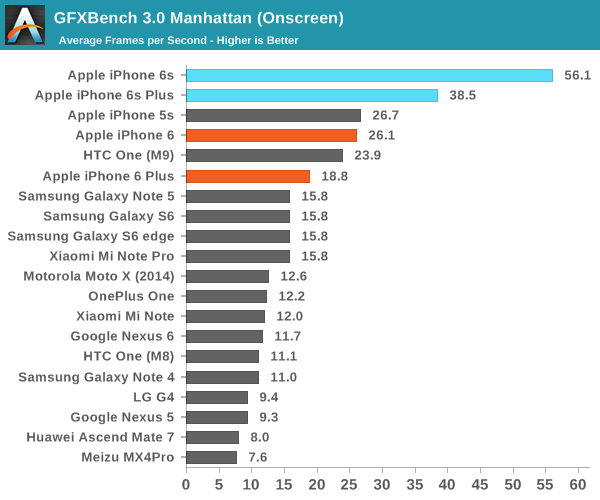
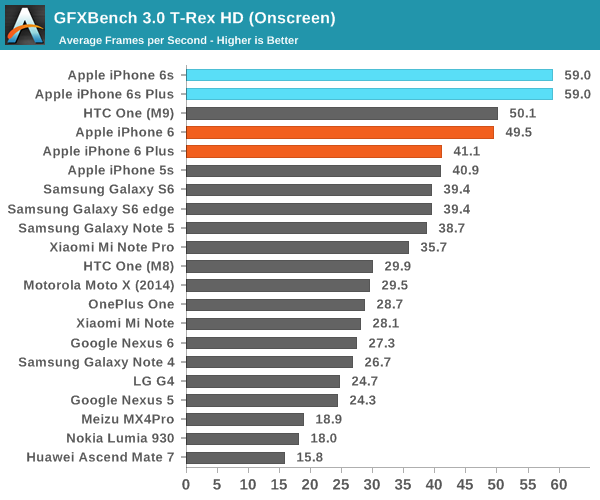
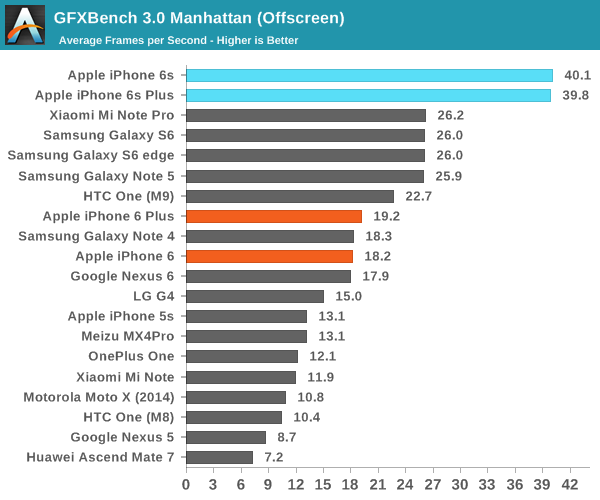

In GFXBench, the A9 SoC just shows absurd performance. It’s strange to think about how the iPad Air 2’s GPU seemed incredibly quick at the time but with the A9 Apple has surpassed that level of performance in their smartphone SoCs. The move to a new generation of PowerVR GPU IP, in addition to the move to a FinFET process node are really the drivers for this kind of performance improvement.
Overall, the Apple A9 SoC is the best SoC in any phone shipping today. In cases like web browsing, gaming, and even just going through the UI it’s quite evident that this new SoC is a major factor in improving performance and smoothness across the board. Something as simple as visiting some popular tech websites will show this, which really goes to show how much “specs” still matter due to their influence on user experience.
NAND Performance
At this point is almost goes without saying that storage performance is important, but in a lot of ways the testing here is still in its early days. In the case of the iPhone 6s we’ve discussed what distinguishes its storage solution from others in this industry, but for those that are unaware the iPhone 6s uses PCIe and NVMe instead of a UFS or eMMC storage solution. In a lot of ways, this makes the storage on board closer to the SSD that you might find in a more expensive PC but due to PCB limitations you won’t necessarily see the enormous parallelism that you might expect from a true SSD. In the time since the initial results we've found that all of our review units use Hynix-supplied NAND. In order to test how this storage solution performs, we use Eric Patno’s storage test which allows for a simple storage test comparable to AndroBench 3.6.
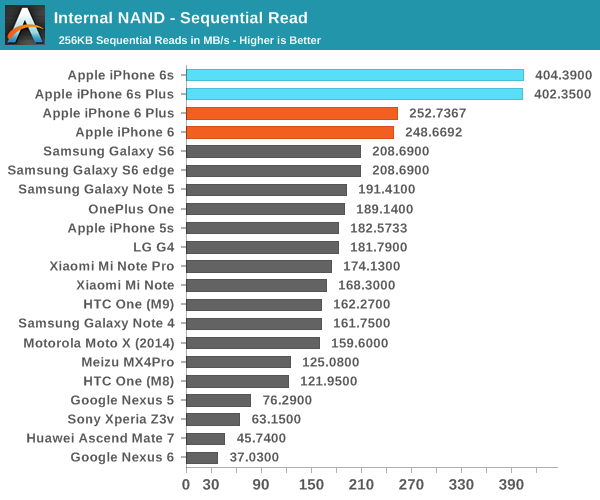
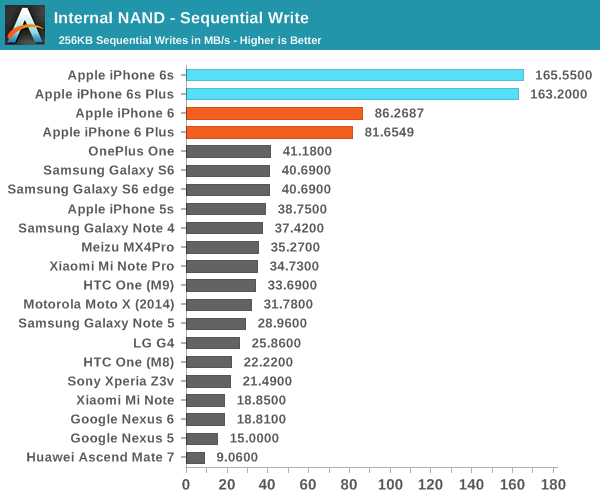
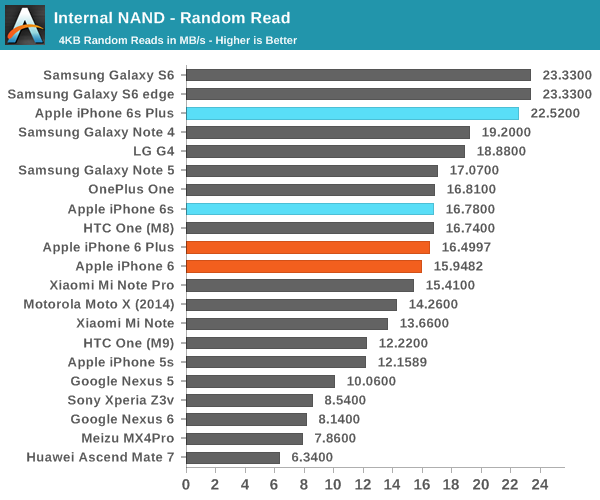
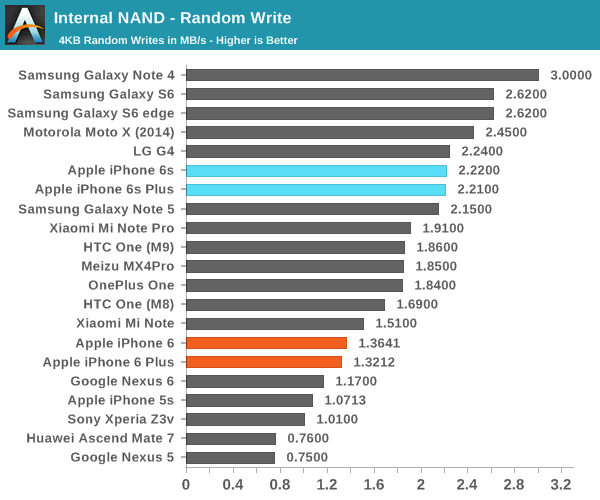
Here, we can really see the enormous performance improvements that result from a combination of TLC NAND with an SLC cache, along with the new NVMe protocol which allows for low CPU overhead and removes architectural bottlenecks to storage performance. This should allow for things like faster burst photos and faster app updates. Downloading and updating apps on the iPhone 6s feels noticeably faster than it is on the iPhone 6, to the extent that small apps feel like they install almost instantly when I’m on a WiFi connection fast enough to saturate storage bandwidth.










531 Comments
View All Comments
Gigaplex - Monday, November 2, 2015 - link
On the other hand, Jim Keller no longer works at Apple. He is the mastermind behind Apples architecture.zeeBomb - Monday, November 2, 2015 - link
Oh man...when was his departure? Who's the lead now?NBvdB - Tuesday, November 3, 2015 - link
Jim Keller left in 2012. That hasn't seemed to stop Apple from continuing to make huge steps forward since then. Current Chief CPU design is Gerard Williams.iwod - Monday, November 2, 2015 - link
Let state a few things.Next SoC aka A10 will not have 12MB Cache. And not 8 Core GPU. Because both of this assumption increase die size and therefore what you are suggesting is Apple jumping to 10nm. Which isn't available to tape out until late 2016 and ready for 2017 iPhone.
The A10 is pretty much set, going to be produced by TSMC 16nm FFC, current A9 is 16nm FF+. 16nm FFC is likely to get 10 - 15% performance / watt while being cheaper to produce. Assuming Apple could further tweak its GPU and CPU, so we really should only expect 20% improvement in next iteration. Which is still a very very good number.
The A11, which will get the TSMC 10nm die shrink, will likely get another major architecture change, so the Quad Core, or 2 Core SMT as well as 8 core GPU design will likely end up there. The 8 Core GPU as well as the frequency improvement with 10nm will / should force Apple to upgrade their Memory bandwidth. The industry is still trying to figure out where to go next. LPDDR5 , which is not even a standard yet has been bought up recently, since Wide I/O 2 still has its problem and challenges. I am not sure if this can be solved in time for A11, if not Apple will likely just choose a faster LPDDR4 instead.
I will love to see a comparison between Apple SoC and Intel Skylake. But I think the A9x with 4 Core will be a better comparison to Intel 2C4T design. Let's hope Anandtech will do that in their iPad Pro review.
zeeBomb - Tuesday, November 3, 2015 - link
I have a feeling though apple can do it. A 10nm process...mobile tech sure evolved nowadays.Alexey291 - Tuesday, November 3, 2015 - link
They have nothing to do with actual manufacturing process. Neither does manufacturing process have anything to do with mobile tech.On the whole your comment made my eyes bleed.
paulwb - Monday, November 2, 2015 - link
well deserved editors choice for the 6s amazed to see that the article didnt stress enough that it was the hardware advancements done by the android OEM that pushed apple to fight back with these high specs and full feature S versions...loved the reviewKevin G - Monday, November 2, 2015 - link
Typo:"In order to test how this storage solution performs, we Eric Patno’s storage test which allows for a simple storage test comparable to AndroBench 3.6."
I think you accidentally the word 'used' in that sentence (unless Eric Patno is a verb).
vastac13 - Monday, November 2, 2015 - link
Now, we need the Nexus 6p in-depth review from Anandtech and hopefully we can see a Gold Choice award from Android CampBrandon Chester - Monday, November 2, 2015 - link
Neither Nexus device does anything to meaningfully move the smartphone industry forward. There's a reason the 6s, and prior to it the HTC One (M7) are the devices that received it.